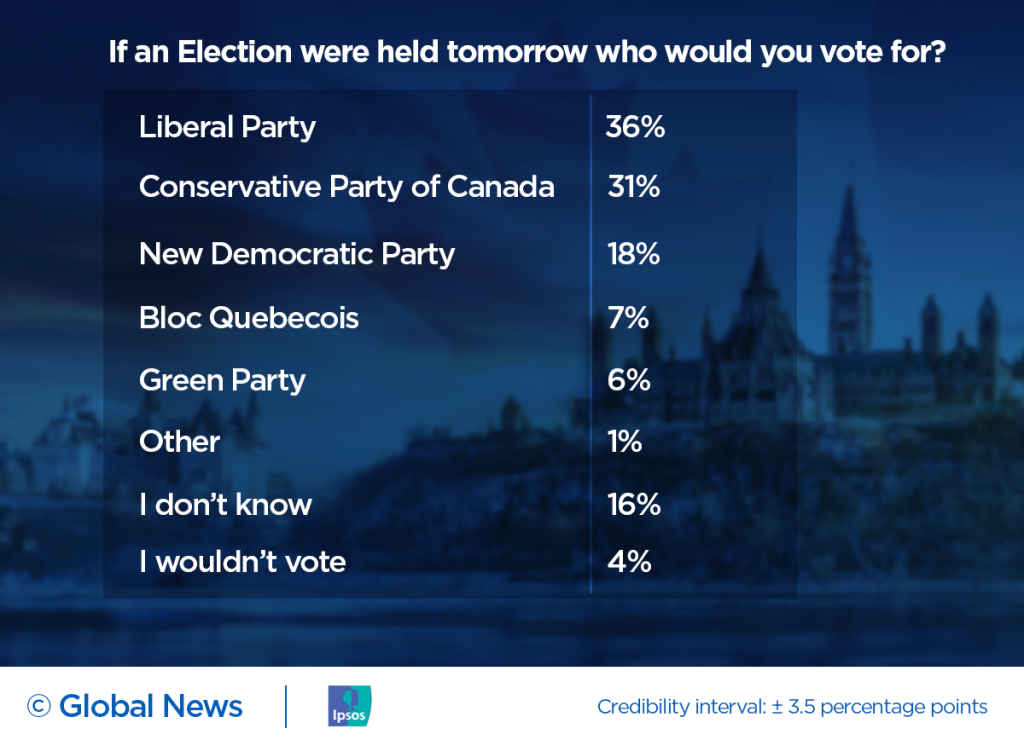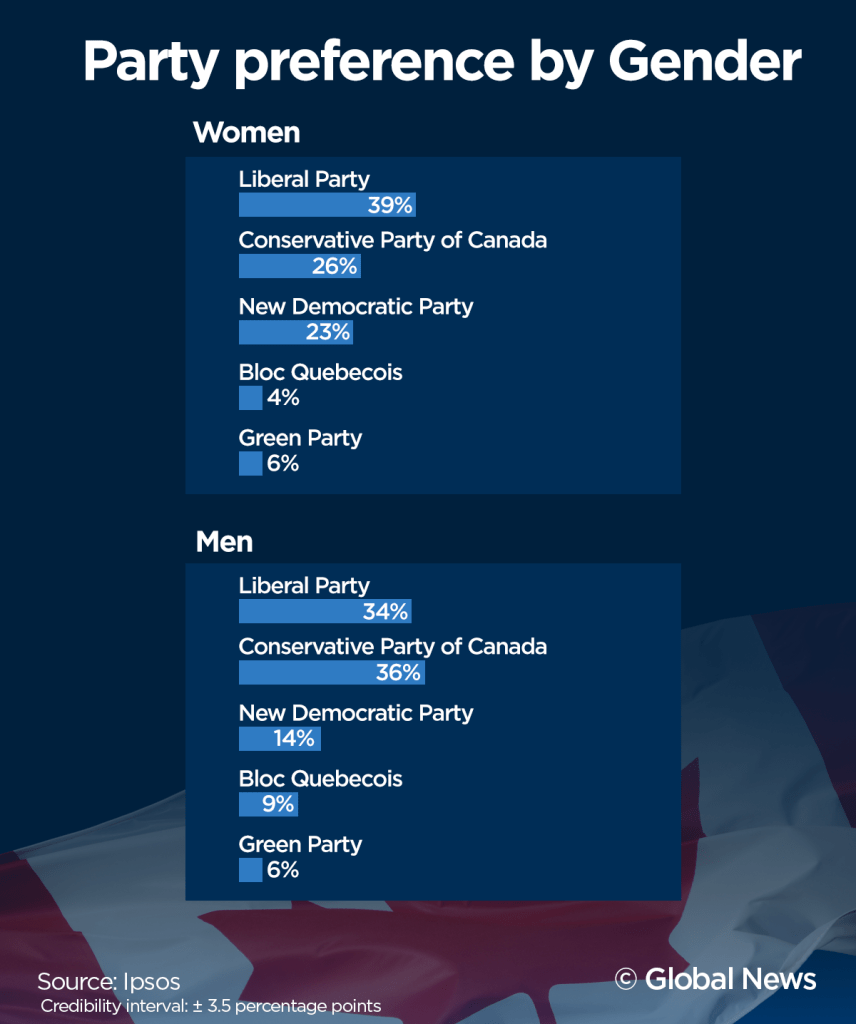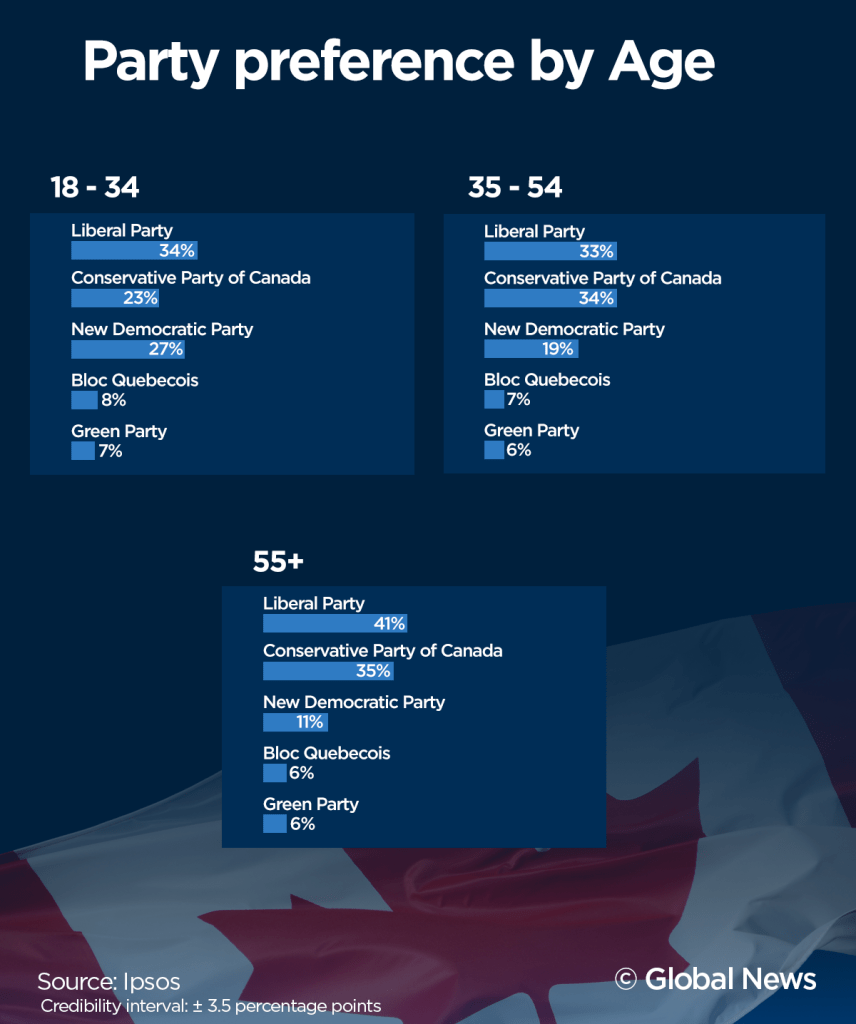Canada’s federal Liberal party experienced a small boost after the new throne speech was delivered and Prime Minister Justin Trudeau addressed the nation, a new poll has found.
The poll, conducted by Ipsos exclusively for Global News, found that if an election were to be held tomorrow, 36 per cent of Canadians would vote for Prime Minister Trudeau and the Liberal party, while 31 per cent would vote for Erin O’Toole and Conservative Party.
The data, collected online between Sept. 29 and Oct. 1, reflects a three per cent increase for the Liberals and a one per cent decrease for the Conservatives, though both are within the online survey’s margin of error.

Eighteen per cent of respondents said they would vote for the New Democratic Party led by Jagmeet Singh, while seven per cent said they would vote for Yves-Francois Blanchet and the Bloc Quebecois.
The Green Party would receive six per cent of the vote if an election were to be held tomorrow. Annamie Paul became the Green Party leader on Oct. 3, after the survey was completed.
Read more:
NDP will back Liberal throne speech, preventing fall election
One per cent of Canadians said they would support some other party, while 16 per cent said they didn’t know whom they would support and four per cent said they would abstain from voting.
Read more:
Throne speech appears poised to pass vote after COVID-19 benefits boost
In the throne speech, Gov. Gen. Julie Payette outlined the government’s plan for a new parliamentary session, focusing on helping Canadians weather the novel coronavirus pandemic.
Hours later, Trudeau addressed the nation, saying the country’s four largest provinces were already experiencing a second wave of the virus.
He urged Canadians to heed the advice of health professionals, and continue practising virus mitigation strategies including hand hygiene and social distancing.
“This is his big opportunity to outline his master plans without really getting into the details of what the consequences are — how much it costs, what the opportunity costs are,” said Sean Simpson, vice president at Ipsos.
“So we would expect to see a bump for the incumbent government, and that’s exactly what we’ve seen.”
However, he added the bump doesn’t yet translate to the party being in majority territory because it comes with a mixed bag in how that support breaks down across the regions.
Read more:
Throne speech appears poised to pass vote after COVID-19 benefits boost
In Ontario, the poll suggests the Liberals have a double-digit lead over the Tories, with 41 per cent and 29 per cent support, respectively.
Meanwhile, the NDP saw 21 per cent of support among Ontarians, while the Green Party would capture seven per cent of the vote.
In Quebec, the Liberals and Bloc were virtually tied, collecting 29 per cent and 28 per cent of support each. The Tories trailed behind with 20 per cent.
The NDP and Greens were further behind with 14 per cent and six per cent of the vote, respectively.
“The fact the Bloc Quebecois is doing well again in the province of Quebec stymies the efforts of the Liberals to march towards majority government,” Simpson said.
“I think that’s partly the reason why you saw the Liberals make such a quick deal with the NDP. It’s not really in anybody’s advantage, except perhaps the Bloc Quebecois’s, to have an election.“
Further west in Alberta, the Conservatives (58 per cent) had a large lead over the Liberals (23 per cent.)
The NDP had 13 per cent of support among Albertans, while the Greens trailed behind at three per cent.
The survey also found support for the parties was split between men and women.
According to the survey, the Liberal Party has more than a 10-point lead with women, while the Tories have a slight lead with men.

The poll found 39 per cent of women said they would vote for the Liberals, while only 26 per cent said they would vote Conservative.
Twenty-three per cent of women said they would support the New Democratic Party, while six per cent said they’d vote for the Greens, and four per cent said they would support the Bloc Quebecois.
Meanwhile, the Tories had a slight lead over the Liberals among men, capturing 36 per cent of support over the Liberals’ 34 per cent.
The NDP, Bloc Quebecois and Green Party garnered 14 per cent, nine per cent and six per cent of support among men, respectively.
What’s more, the poll found different age groups had differing opinions on whom they would support.
The survey found the Liberal party was most popular among millennials, while the Conservatives and Liberals were virtually tied among voters between the ages of 35 and 54.
According to the poll, 34 per cent of respondents between the ages of 18 and 34 said they would support the Liberal party, and 27 per cent said they would vote NDP.

Twenty-three per cent of millennials said they would vote for the Tories, with the Bloc and Green parties trailing behind at eight and seven per cent, respectively.
The survey found that among respondents aged 35 to 54, some 34 per cent said they would support the Conservatives, 33 per cent said they would support the Liberals, 19 per cent said they would support the NDP, followed by the Bloc at seven per cent and the Greens at six per cent.
But perhaps most surprising is the shift in support toward the Liberals among baby boomers.
According to the poll, the Liberals were the most popular among voters aged 55 and older at 41 per cent. The Conservatives garnered 35 per cent of support while the NDP was further behind at 11 per cent.
The Bloc Quebecois and Green Party each collected six per cent of support from the age group.
Simpson said that result jumped out to him given the demographic has traditionally been staunchly supportive of the Conservatives, and forms a key bloc of that party’s voter base.
“In order for the Conservatives to have a shot to be competitive at defeating the Liberals, there are two groups of people where they absolutely need to win — not just be competitive, but win probably by close to double digits,” Simpson said, noting a similarly unusual result among male voters.
“Right now, there isn’t much of a gap in terms of support for the Liberals or the Conservatives amongst men — the Conservatives are only up by two points.
“In order for them to do well, that needs to be five, closer to 10 points.”
METHODOLOGY: This Ipsos poll was conducted online between Sept. 29 and Oct. 1, 2020. Quotas and weighting were employed to ensure that the sample’s composition reflects that of the Canadian population according to census parameters. The precision of Ipsos online polls is measured using a credibility interval. In this case, the poll is accurate to within ±3.5 percentage points, 19 times out of 20, had all Canadians aged 18 and over been polled. The credibility interval will be wider among subsets of the population. All sample surveys and polls may be subject to other sources of error including, but not limited to, coverage error and measurement error.






